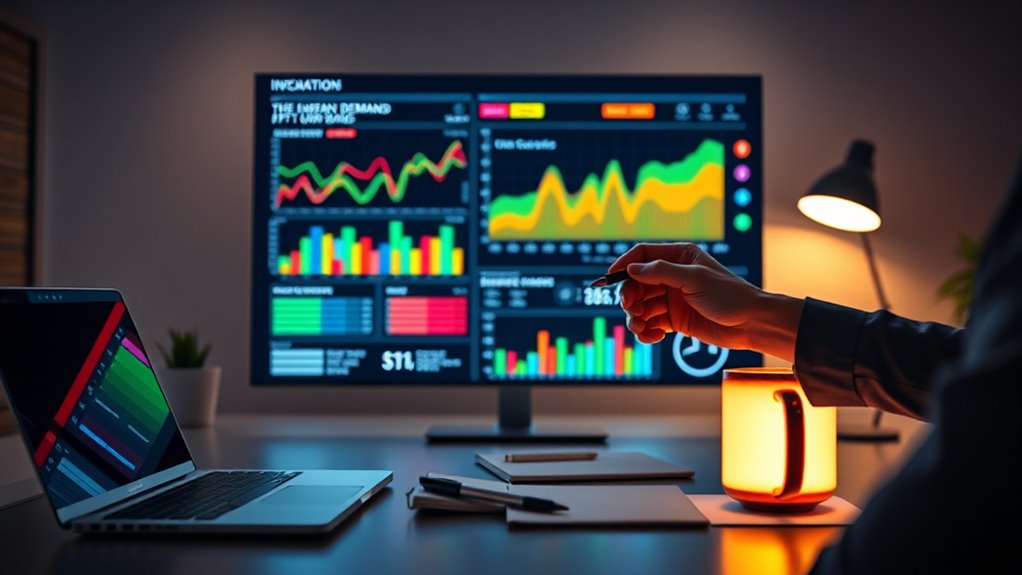Energy demand forecasting helps you predict how much power will be needed, making your energy system more reliable and efficient. By analyzing past data, weather patterns, and economic factors, you can better plan resources and manage renewable sources like wind and solar. Modern tools and machine learning simplify this process, allowing you to stay ahead of supply and demand changes. Keep exploring to discover how these techniques can make your energy management smarter and more sustainable.
Key Takeaways
- Use historical consumption data combined with weather, economic, and social factors for accurate demand forecasts.
- Employ machine learning models that adapt and improve as new data becomes available.
- Simplify analysis with modern software tools designed for large datasets and real-time updates.
- Incorporate renewable energy forecasts to manage variability and enhance grid resilience.
- Apply demand forecasting strategically to optimize resources, prevent outages, and support a sustainable energy future.

Energy demand forecasting plays a crucial role in ensuring reliable and efficient power systems. When you accurately predict how much energy will be needed, you help prevent outages, reduce waste, and optimize resource use. This is especially true as the energy landscape shifts toward incorporating more renewable sources like wind and solar. As renewable integration becomes a priority, understanding future demand helps balance these variable supplies with consumption patterns, maintaining grid resilience. Without solid forecasts, integrating renewables can lead to instability and inefficiencies, making demand prediction essential for a resilient grid that can adapt to changing conditions.
Forecasting isn’t just about guessing future energy needs; it’s about using data, patterns, and sophisticated models to make informed decisions. When you leverage historical consumption data, weather forecasts, economic indicators, and even social trends, you build an all-encompassing picture of future demand. This allows utilities and grid operators to plan ahead—allocating resources, scheduling maintenance, and managing capacity effectively. Accurate forecasts mean fewer surprises and smoother operations, even when unexpected events like heatwaves or cold snaps hit.
One of the biggest challenges in modern demand forecasting is accounting for the growing share of renewables. Unlike traditional power sources, renewables depend heavily on weather conditions, which are unpredictable. When you factor in the variability of wind speeds or sunlight, forecasting becomes more complex but also more critical. By integrating renewable generation forecasts with demand predictions, you can enhance grid resilience. This integration helps you identify potential shortages or surpluses early, enabling proactive measures such as dispatching energy storage or adjusting demand response programs. The goal is to keep the lights on without over-relying on fossil fuels, reducing environmental impact while maintaining stability.
To simplify demand forecasting, you don’t need to be a data scientist. Modern tools and software make it easier to analyze large datasets, identify trends, and generate reliable predictions. These tools often incorporate machine learning techniques that improve accuracy over time, adapting to new data and changing conditions. As you get more comfortable with these systems, you’ll see how they empower you to make smarter decisions—whether it’s scheduling maintenance, planning for peak loads, or integrating more renewable energy sources.
In essence, energy demand forecasting isn’t just a technical task; it’s a strategic tool that ensures your power systems remain resilient amid a rapidly changing energy landscape. By understanding and predicting demand accurately, you support a cleaner, more reliable, and more sustainable energy future. As renewables continue to grow, your ability to forecast demand effectively becomes even more critical in maintaining grid stability and resilience. Recognizing the importance of color accuracy in projectors can help improve visualization for planning and monitoring these energy systems, making it an essential aspect of modern energy management.
Frequently Asked Questions
How Accurate Are Current Energy Demand Forecasts?
You might find that current energy demand forecasts are quite accurate, especially when they incorporate renewable integration and consumer behavior patterns. By analyzing data from renewable sources and understanding how consumers use energy, these forecasts improve in precision. However, unexpected factors like weather or technological shifts can still cause deviations. Overall, with ongoing advancements, you can expect forecasts to become even more reliable in predicting energy needs.
What Are the Main Challenges in Demand Forecasting?
You face challenges like accurately predicting demand, especially during peak load times when consumption spikes unexpectedly. Integrating renewable energy sources adds complexity, as their variability makes forecasting less precise. You also need to take into account factors like weather changes and consumer behavior shifts. These issues make it harder to create reliable forecasts, requiring advanced models and real-time data to better manage energy supply and meet demand effectively.
How Do Weather Changes Impact Energy Demand Predictions?
Weather changes considerably impact your energy demand predictions. Climate variability and temperature fluctuations cause unpredictable shifts in usage patterns, making it harder to forecast accurately. Sudden cold snaps increase heating needs, while heatwaves boost cooling demands. You need to account for these variations to improve accuracy, adjusting models to reflect changing weather conditions. By understanding how climate variability influences energy use, you can make more reliable predictions and optimize resource management effectively.
Can Demand Forecasting Adapt to Sudden Market Shifts?
Did you know that 65% of energy companies report difficulty adapting to sudden market shifts? You can adapt demand forecasting by using real-time data and advanced models. Incorporate renewable integration to anticipate fluctuations and refine pricing strategies effectively. Staying flexible allows you to respond quickly to unexpected changes, ensuring reliable supply and optimized profits. Embracing these approaches helps you stay ahead, even during unpredictable market conditions.
What Role Does AI Play in Improving Forecasts?
AI plays a vital role in improving forecasts by leveraging machine learning and data analytics. You can use AI to analyze vast amounts of data quickly, identify patterns, and adapt to market shifts in real-time. This helps you make more accurate predictions, even during sudden changes. By integrating machine learning algorithms, you gain insights that enhance your forecasting precision and responsiveness, keeping your energy management efficient and reliable.
Conclusion
By understanding energy demand forecasting, you can better anticipate future needs and make smarter decisions. Did you know that accurate forecasts can reduce energy costs by up to 10%? This highlights how simple techniques can lead to significant savings and efficiency. Whether you’re managing a household or a large grid, applying these methods helps optimize resources and supports sustainable energy use. Embrace these tools, and you’ll stay ahead in meeting tomorrow’s energy demands effortlessly.










